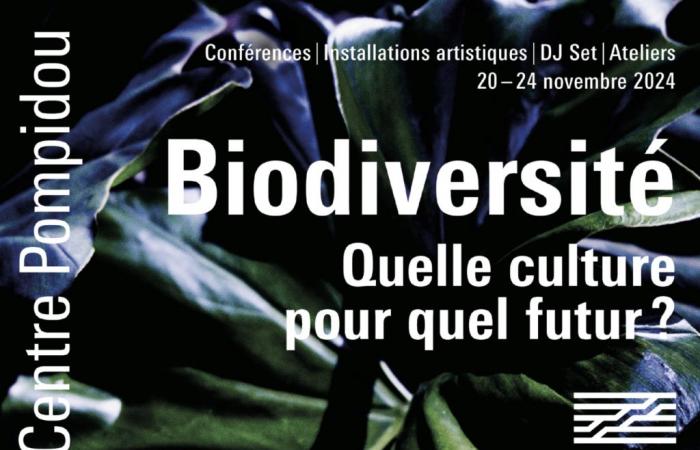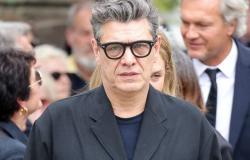©Marguerite Bornhauser
Hello to you, I am delighted to finally have the opportunity to share a moment with you. My first question is simple, please introduce yourself?
My name is Mathieu Potte-Bonneville, I have been responsible for the culture and creation department of the Center Pompidou since 2019, it's not from yesterday! The culture and creation department is in charge of the living programming of this establishment. Furthermore, I am a philosopher by training, lecturer at the Ecole Normale Supérieure of Lyon. And there you have it!
And that’s already not bad! And you Eva?
I am Eva Daviaud, responsible for foresight and social innovation within the culture and creation department. I work both on programming topics on societal issues and I work for the transformation of the establishment on social responsibility issues.
Knowing you both a little, there is one thing that surprised me when I discovered the program, it was its name… I imagine that you don't name it in an artificial way? What I would naturally have called a “focus” or a “festival” (laughs), you call it a “forum”, where did it come from?
MPB: First of all, there is a tradition. The forum is the name of one of the center's spaces. The forum is the central space, “forum zero – forum minus 1” – which Piano and Rogers really thought of as facing the Piazza, a direct extension of this exterior public space by an interior public space and therefore the idea of forums in the architecture of the building is the idea that the Center Pompidou is a place which must be able to accommodate. That it has a role, an almost political function, in any case civic, both of bringing together visions and different modalities of expression. From there, social forums were born, which quite regularly intervened in the center's programming throughout history.
So, this term “Forum” is not new?
MPB: Indeed, we should do a “history of social forums since 1977”. On several occasions, and for a long time, programs have taken this title. Recently, Jean-Marc Scolard, in the service of speech, scheduled “major social forums”after the fire at Notre-Dame for example or after the first election of Donald Trump… (appalled faces) It’s terrible to say “the first election of Donald Trump…”. Finally, three years ago, the idea of these forums slowly emerged, each end of the year: to offer a moment of meeting and convergence, of disciplines and citizen discourse, around artistic and societal issues.
What were the previous forums?
MPB: The first one was called “Climate, which culture for which future? »the second “Lead the way”for the 40th anniversary of the equality march against racism.
For this 3rd edition around biodiversity, Eva, have you noticed an evolution in the work of artists in the forms that are used? Art is obviously political. How do artists take up this social subject, are there particular movements such as stand-up, documentary, etc. to carry these subjects?
ED: There are different ways of presenting subjects and it's something that sparked debate within the team, in any case which brought out thoughts on what is a committed artist? Is this an artist who, for example, is keen on environmental subjects in his personal commitments but who does not necessarily address these subjects in his work? It's a tricky question, “where to place the cursor?” », an artist who addresses these subjects can also have a lifestyle which sometimes deviates from ecological radicalism. Are these projects which from an aesthetic point of view make complete sense and take you into a story but which from a scientific point of view do not hold up at all? We had very interesting discussions with
sometimes there were ideas which, from the point of view of poetics and aesthetics, were interesting, but on the contrary did not hold up from a scientific point of view.
There is this new project with Bjork, in the Center caterpillar, does that look great?
MPB: I believe that the forum's programming reflects this diversity of approaches quite well. The subjects can be subject to appropriation by mediums which are very different from each other and in the programming. Particularly on Saturday, we are dealing with one of the artists who practice performance, cinema, visual arts like Fabrice Hubert, design therefore who in fact bring the entire palette into play. Our choices focused on artists who strike a balance between attention to the modalities of their own practice and the message that they wish to deliver and who draw interesting cross-sections, for example Momoko Seto, who is at both researcher and filmmaker, wears a double helmet. Fabrice Hyber, who is a visual artist and questions the territory and agricultural practice in its various aspects.
Important question, how many artists and speakers are mobilized for this forum?
ED: Around thirty all the same. We also have 80 engineering students – 40 cultural institutions, who will work together, in a very concrete way, on how we collectively change our practices and then professionals who will also meet during a conference this Friday.
MBP: An important concern of the French Biodiversity Office is to consider that “the public does not exist”, there are audiences, expertise and lots of ways of being concerned by the subject. Hence the plurality of experts and artists requested, it will not just be shows.
Which experts for example?
Experts on social responsibility who have come together in an informal network since 2022 at the initiative of the “climate forum” and who return to simply exchange good practices between museums, places of art and culture. We are talking about between 30 and 300 people in the end.
It's huge! I really want us to come back to Bjork if you want?
MBP: yes, the famous “common thread”, Bjork and Aleph. Bjork is an artist who has been concerned for a very long time and very insistently with the ecological question. No doubt because it is attached to a territory, Iceland, which is particularly revealing of the issues of ecological transformation.
©Bjork
Coming back to her, how is Bjork a figurehead on this forum, beyond her popularity?
MBP: Bjork, as you know, works on hybridization: in her own stage outfits, her masks. All of his recent work revolves around hybridization with the living, hence this idea of hybridization between his voice and that of extinct or endangered species. The figure of Bjork stands out with a “sound work”, to recall the threat weighing on the living, a sort of alert, resounding at regular intervals, in the Center Pompidou.
This looks really great, you'll get a lot of people I hope. Which brings us to my next question. Do you have feedback, from visitors, who, thanks to your forums, have changed, reflected, on their practice, their environmental impact?
ED: Yes, I am thinking of a person who came to see me following the “Climate Forum”, to tell me that she had changed careers and had become involved with Extinction Rebellions. Yes, it’s radical! (General approval and laughter) ED: In fact, we are sowing seeds with these forums – the question of impact measurement is one of the subjects that we will discuss with my establishment sustainable development referent counterparts – because today Today there is no measurement benchmark yet.
You are talking about other establishments, what do you mean by that?
MBP: We chose to include the word “culture” within the title of the forum in 2022, and again in 2024, because we consider that it is part of cultural work. Culture is obviously, on the one hand: the works of creation, in the institutional sense of the term, art and creation. A cultural establishment has an almost anthropological role. But, it is also the common culture, the representations, the ways of seeing the ways of doing things. Questioning what can lead people to change their practices or not can create bifurcations of ambition, of ideas, in life journeys.
So that was one of the ambitions of this project in 2022, to show inspiring alternatives in the face of the ecological emergency, or am I wrong?
MBP: Yes absolutely. Bring together students, ask them to speak, and imagine a kind of performance which basically says: “Well, that’s basically this gesture, it’s cultural. It concerns culture because it moves the lines including art and creation. »
My last question finally concerns the center itself. You will soon close, is the Center Pompidou today in line with the ideas supported by the initiative of this forum?
MBP: (laughs) So, we are not closing, we are transforming!
ED: On the contrary, we are going to open up to the world, through these renovations. For 4 years already, an environmental action plan, which, with these forums, marks our evolution, I have really been able to see progress in raising awareness among the teams.
Do you have any examples?
ED: the question of storage space was previously unthinkable. The idea had always been to have as much space as possible to accommodate the public, except that it was to achieve eco-design and real employment and therefore also budgetary savings. The museum teams were completely aware of the need to fight for square meters of storage space because we admitted that this was the condition for being able to carry out the professions in the way they will be carried out in 2030 according to the Massy agreement. Initiating an event like the “Biodiversity Forum” is an opportunity to question each stage of the design of the event, from production to communication itself (the paper brochures). The vast majority of invited artists come by train.
MBP: That’s a good question. Today there are no places, no institutions, which are in concrete adequacy with the requirements of the time in terms of ecology and environment.
And how do you think this is done? What is at stake in this lack of adequacy?
MBP: We live in a fractured world. We all struggle on different scales with contradictions. In this sense, there is nothing easier than to put an institution in contradiction with itself and to point out what is wrong. Our conviction is that “this” is the good, the starting point for reflection and analysis and that from there we must move, we must evolve.
My question is not at all incriminating, it is only the fruit of my curiosity!
MBP: (laughs) yes I know. The Center Pompidou is a building that was designed in the 1970s, before the first oil crisis. Today it is a thermal sieve. If we have to close, it's to solve our problems. Insulation, to change the air conditioning system, to protect the works without spending an insane amount of energy. A large institution must carry out this metamorphosis and align itself with the ecological imperatives, of pre-serialization of biodiversity, of the time.







